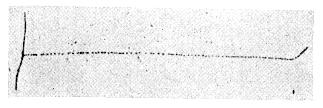
Figure 2: Polar diagram of

Angular Distribution of Particle Accompanied 252Cf Fission:

Figure 2: Polar diagram of ![]() -particle energy versus the
emission angle
-particle energy versus the
emission angle ![]() with respect to the light fission
fragment, for 252Cf.
with respect to the light fission
fragment, for 252Cf.
Most of the ternary particles are emitted about perpendicular to the
fission axis; hence they are not evaporated from the accelerated fragments.
Fig. 2 displays the double differential yield
 and the corresponding single angular
spectrum
and the corresponding single angular
spectrum  [Mut93]. Both figures exhibit
besides of the dominant equatorial
[Mut93]. Both figures exhibit
besides of the dominant equatorial ![]() -particles also the
small fraction of predominantly higher energetic polar
-particles also the
small fraction of predominantly higher energetic polar ![]() -particles
being emitted along the fission axis and under small angles with
respect to the directions of the light and heavy group of fission
fragments. The mean angle
-particles
being emitted along the fission axis and under small angles with
respect to the directions of the light and heavy group of fission
fragments. The mean angle ![]() and the width of the
angular distribution for the different light charged particles (LCP)
emitted in a ternary fission process are summarized in
table 1. The most probable angle of emission
and the width of the
angular distribution for the different light charged particles (LCP)
emitted in a ternary fission process are summarized in
table 1. The most probable angle of emission ![]() is always determined with respect to the direction of the light (L)
fragment. All these data were obtained with lower energy cut-offs
which result from the use of absorber foils to prevent the registration
of the rare ternary LCP's from interference with the several orders
of magnitude more frequent fission fragments or
is always determined with respect to the direction of the light (L)
fragment. All these data were obtained with lower energy cut-offs
which result from the use of absorber foils to prevent the registration
of the rare ternary LCP's from interference with the several orders
of magnitude more frequent fission fragments or ![]() -particles
from radioactive decay.
-particles
from radioactive decay.

Figure 3: Angular distribution of ternary ![]() -particles
in spontaneous fission of 252Cf, as a function of the angle
-particles
in spontaneous fission of 252Cf, as a function of the angle
![]() relative to the direction of the light fission fragment.
relative to the direction of the light fission fragment.

Table 2: Mean emission angle ![]() and angular width
of the light charged particles (LCP) emitted in the ternary fission
process of 252Cf. The most probable angle of emission
and angular width
of the light charged particles (LCP) emitted in the ternary fission
process of 252Cf. The most probable angle of emission ![]() is always determined with respect to the direction of the light (L)
fragment. The used energy cut-offs are also given (see text).
is always determined with respect to the direction of the light (L)
fragment. The used energy cut-offs are also given (see text).